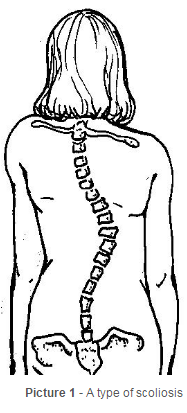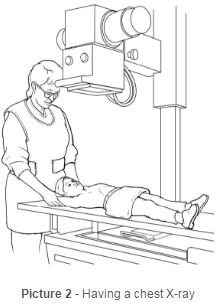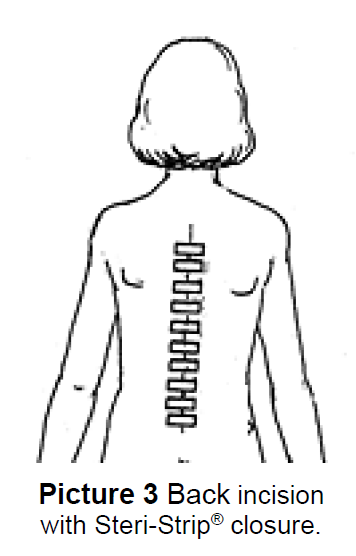Spinal Fusion

Spinal fusion is a surgery that may be needed with severe cases of scoliosis. Scoliosis (skoh-lee-OH-sis) is a twisting and/or curving of the spine (Picture 1). Scoliosis happens as your child grows, especially during growth spurts in their teens. Scoliosis is sometimes noticed when one shoulder or hip looks higher than the other. In some cases, scoliosis can be treated with a brace to keep it from getting worse. There are several types of scoliosis. Three of the most common types are:

- Congenital - A curving of the spine present at birth caused by a malformation of the vertebrae.
- Idiopathic - A curving of the spine that usually appears during the teen years. The cause is not known.
- Neuromuscular - A curving of the spine caused by a defect in the nervous or muscular system.
An instrumented spinal fusion is an operation done to correct the curvature of the spine. It is called instrumented because rods are attached to the spine to correct and hold it in place during surgery. This allows it time to fuse. There are a few names for the devices that are used to hold the spine in place. Your child’s health care provider will decide which one is best for them.
Before Your Surgery
Preoperative Orthopedic Visit
Once your child’s surgery is scheduled, they will go to the orthopedic clinic for a pre-operative visit. A nurse will get a medical history, including medicines and family history.
A nurse practitioner will do a physical exam and get blood work if needed.
At this visit, x-rays may be taken of your child’s back (Picture 2). We will discuss the spinal fusion surgery, what to expect during your child’s hospital stay and recovery at home. You can also ask any questions you may have about the upcoming surgery. At this time, your preoperative blood work and labs will be reviewed. A pregnancy test for menstruating females is done on the day of surgery.
Other Tests

Some tests may be ordered only if your child has other health issues. These tests are not done at the time of the preoperative appointment. They will be scheduled as needed.
Dental Checkup
Be sure to make an appointment with your child’s dentist for a checkup. It is important their teeth are in good condition, cleaned and cavities filled before the surgery. This is done to make sure your child does not have any dental disease or bacteria in their system that could cause infection at the surgical site.
The Surgery
- On the day of surgery, your child will be admitted to the surgery unit.
- The surgery may take 6 hours or longer. After that, your child will be in the Post Anesthesia Care Unit (PACU) for about 2 to 3 hours. Depending on when your child leaves the Pre-Op area, it may be 8 to 10 hours before they return to the unit.
- You will wait in the Surgery Family Waiting Room while your child is in surgery. It is important that the parent or guardian stay in this area in case the doctor needs to talk with them.
After the Surgery
- The doctor will talk with you after the surgery.
- When your child arrives at the unit, their nurse will review the doctor’s orders and will answer your questions. After your child comes back from surgery, up to 2 caregivers (parents or guardians) over the age of 18 may stay overnight in the child's room. No siblings may stay overnight. If you need a place to sleep, talk with your child's nurse.
- Your child may need to be admitted to the Pediatric Intensive Care Unit (PICU) after surgery. Visiting hours and rules are different there. If your child is in the PICU, the staff will work with you to plan a visiting schedule to decide who will visit and when.
- Your child will go home when they are tolerating their regular diet, no longer need IV pain medicine and can walk up and down the hallway. If your child uses a wheelchair at home, they will be required to be able to sit up in their chair.
- A provider will review all homegoing instructions including medicines, incision care, activity restrictions and reasons to call your child’s provider.
At Home
Personal hygiene and incision care

- Over the incision, there may be a white pad with plastic or tape-like strips, called Steri-Strips® (Picture 3).
- Your child will be able to take a shower after they go home unless their health care provider says not to. Your child needs to stand facing the shower, so the water does not directly run over the dressing. Pat the dressing dry after showering. If you notice any drainage that looks different after your child is home, or the dressing is falling off, call the spine nurse for instructions on how to change the dressing.
Activity
Your child needs to follow these directions:
- Avoid strenuous physical activity and contact sports.
- Walk three times a day. Increase the amount and distance as they feel comfortable. Be sure to take plenty of rest when needed.
- No bending, lifting, pushing or pulling until your child’s health care provider says it is okay.
- Follow the health care provider’s orders. Ask any questions you have.
Nutrition
- After your child goes home, they may eat their usual foods unless their health care provider tells you otherwise. It is important to eat a balanced diet after surgery to promote healing.
- Your child should not try to lose weight during this time.
- Your child should drink lots of non-caffeinated liquids and eat lots of fresh fruits and vegetables.
- Your child should take a multivitamin with iron for 3 months after surgery.
When to Call the Orthopedic Clinic
Call the spine nurse if any of the following occurs:
- drainage or a foul odor from the incision
- fever more than 101 degrees F (38.3 degrees C) taken by mouth
- incision gets red
- incision gets more tender or swollen
- incision begins to separate
- increase in back pain
- new numbness or tingling
HH-I-91 7/85 Revised 2/21 Copyright 1985, Nationwide Children's Hospital
